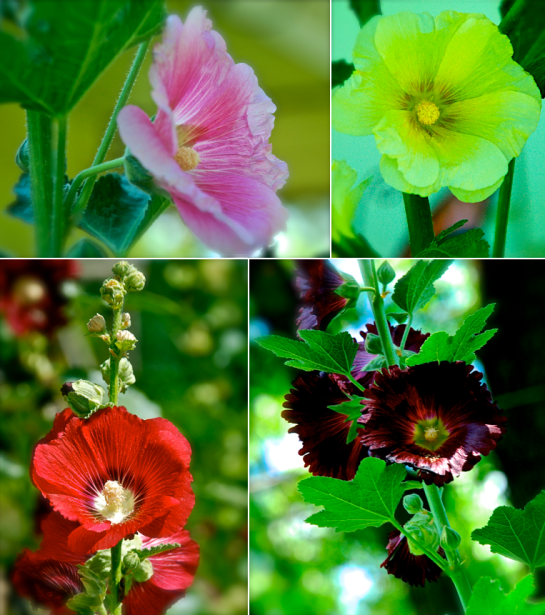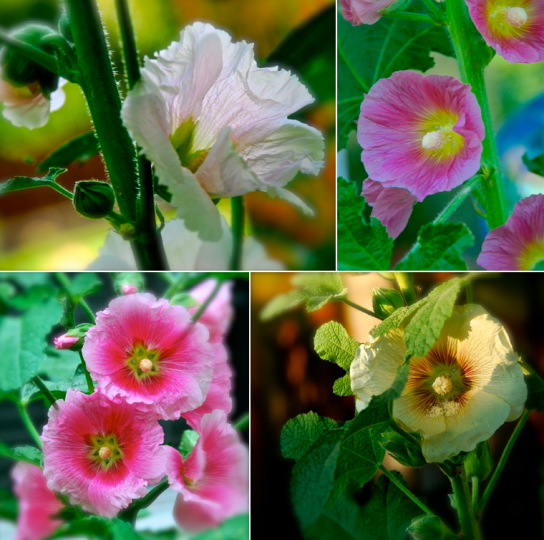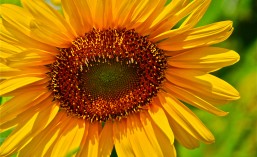Old-fashioned flowers! I love them all:
The morning-glories on the wall,
The pansies in their patch of shade,
The violets, stolen from a glade,
The bleeding hearts and columbine,
Have long been garden friends of mine;
But memory every summer flocks
About a clump of hollyhocks.
~Edgar A. Guest

You may have noticed that I’ve been posting lots of photos of hollyhocks lately. Why? There are two reasons: first because they are one of my favorite flowers and secondly because the hollyhock is a flowering plant of such antiquity that it was found at a neanderthal burial site, where it had stood as a silent sentry for eons. And then after the neanderthal era the hollyhock, a member of the mallow family, was grown in religious gardens around churches and monasteries, and hollyhock seeds were included in the cargo on early ships to the Americas.

So the tall, showy hollyhock has been used in gardens all over the world and for those tens of thousands of years their chalice-like blossoms, when facing upward, have captured and held countless dollops of daylight while captivating mortals and pollinating creatures alike with their winsome ways. The name hollyhock probably resulted when crusaders brought this versatile plant to England. Holy and hoc (mallow) were the terms associated with it at that time. The sturdy plant gained popularity and even became the subject of a 15th-century poem. However, over the years and sadly, at least hereabouts, less and less of them are to be found in gardens, even gardens where they were once considered a staple.

Those red hollyhocks are at the back of our lot,
and I think they are even taller than 9 feet.
So the tall, showy hollyhock has been used in gardens all over the world and for those tens of thousands of years their chalice-like blossoms, when facing upward, have captured and held countless dollops of daylight while captivating mortals and pollinating creatures alike with their winsome ways. The name hollyhock probably resulted when crusaders brought this versatile plant to England. Holy and hoc (mallow) were the terms associated with it at that time. The sturdy plant gained popularity and even became the subject of a 15th-century poem. However, over the years and sadly, at least hereabouts, less and less of them are to be found in gardens, even gardens where they were once considered a staple. So I’ve been thrilled that the last two years I’ve been having such great luck with growing them. I especially like that they sometimes reach a height of 9 feet or more which means they tower above all else in a garden; also wherever they grow, the flowers attract hummingbirds and butterflies. Miracles are they then? I think so. The first miracle is that all the data needed to replicate this lovely giant and its flowers is stored In something as small as one of my freckles. The next miracle is that for thousands upon thousands and thousands of years the small seeds have not perished nor failed in their purpose. The third miracle is that the Lord ordained pollinators along with the sun, soil, and water, to be faithful guarantors of the hollyhock’s lifeline.

How could anything be more amazing than that God not only created all that is and devised ingenious ways for everything He made to be replenished, but that he also valued the importance of beauty as well as purpose. The Lord created not just a human body that needs tangible nourishment but also a soul in the physical body that needs to be fed in spiritual ways, a soul that longs for and seeks its beautiful Source.
Life is more than food, and the body more than clothes. -Luke 12:23 ✝
**All photos taken by Natalie; collages created by Natalie
